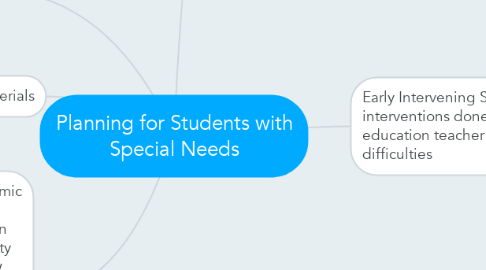
1. PLAAFP: Present Level of Academic Achievement and Functional Performance - it sets a foundation for what a student with a disability can currently do in order to know how best to help them and improve. What is their current academic and functional performance currently? What strategies have already been used? What are the grade level standards?
1.1. It involves both academic performance, functional performance, motor skills, social and emotional state, and communication skills.
1.1.1. The PLAAFP statement will include assessment results, observations, grades, strategies accomadations or ATs already used that have been successful.
1.1.1.1. The information should be specific. Ex/ can't talk well vs. speaks in 1 or 2 word sentences. Difficulty following classroom rules vs. follows classroom rules using visual cues.
2. PATINS: Promoting Achievement through Technology and Instruction for all Students
2.1. a lending library that lends AT devices to students for 6-week period to see if it will work for the student
3. AEM: Accessible Educational Materials
3.1. a resource that ensures digital technology in the classroom is accessible for all learners. digital does not equal accessible for all students, providing ways for content within a device to be accessed.
4. Early Intervening Services: Initial interventions done by the general education teacher to address student difficulties
4.1. IDEA allows federal special education funds to be used for early interventions
4.2. They commonly take two forms: student support teams and RTI models
4.2.1. student support teams: specific intervention strategies to increase a student's sucess
4.2.2. RTI: high quality, effective instruction in the gen. classroom to match the needs of a student struggling with basic academic skills
4.2.2.1. one approach: high quality instruction for whole classroom -> assessments to identify struggling students -> intensive instruction for those students w/ curriculum based measure assessments -> intensive instruction focused on specific skills w/ frequent progress monitoring
4.2.2.1.1. Referral for Special Education Services: if a student's difficulties are too challenging and interventions are unsuccessful or not available, a student can be referred to special education services
5. SETT: Method that helps to choose an appropriate AT device for a child with special needs
5.1. Student: Information about the student. What are functional areas of concern? What is the student unable to do or have difficulty with? What are student's current abilities? Etc. Goal is to determine what the student needs to able to do
5.1.1. Environment: Info about where the student will be using the AT. Layout of classroom, support from staff, materials and equipment in room. Info about the cafeteria and playground, home environments, etc.
5.1.1.1. Tasks: Info about what happens in the environment. Tasks are what the student will have to do in the specific environments. Different than functional areas of concern
5.1.1.1.1. Tools: Includes all devices, strategies, and services that the student needs to succeed from no tech strategies to high tech devices. Must include everything, even things such as an extension cord for use with a laptop computer.
